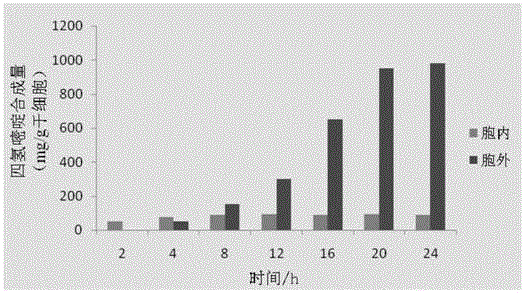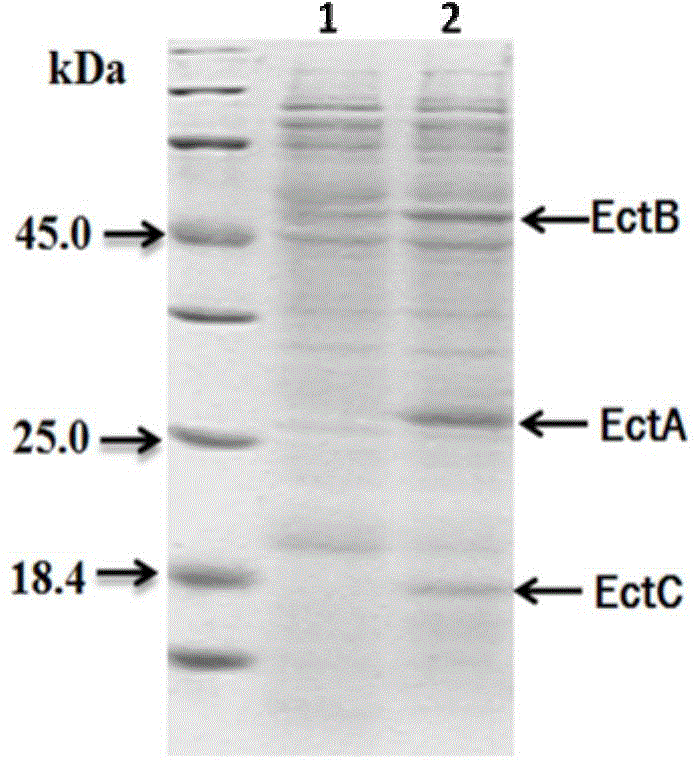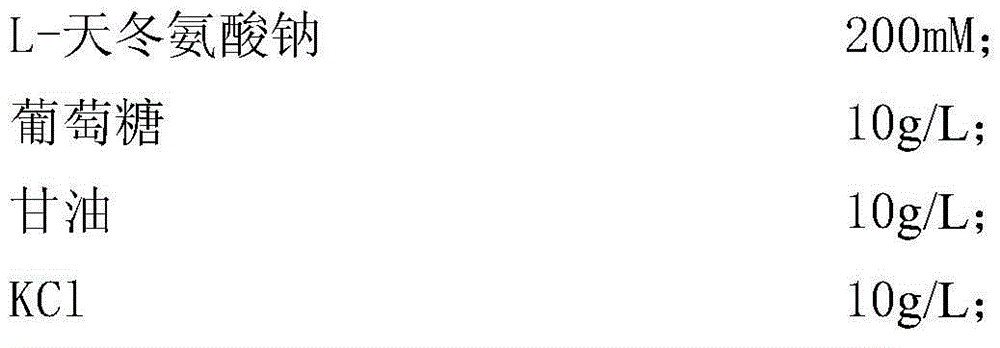Escherichia coli engineering bacterium for high-yield tetrahydropyrimidine and applications of escherichia coli engineering bacterium
A technology of tetrahydropyrimidine and Escherichia coli, applied in the field of genetic engineering, can solve the problems of affecting the growth of bacteria, increasing the production cost, affecting the output of tetrahydropyrimidine, etc., and achieving the effect of efficient secretion and synthesis
- Summary
- Abstract
- Description
- Claims
- Application Information
AI Technical Summary
Problems solved by technology
Method used
Image
Examples
Embodiment 1
[0039] Example 1, Construction of Escherichia coli ectoine high-yield strain BW-pBAD-ectABC
[0040] (1) Expression of ectoine synthesis gene cluster EctABC in Escherichia coli
[0041] 1. PCR amplification of the coding sequence of the ectoine synthesis gene cluster EctABC
[0042] Using the genomic DNA of Halomonas elongate (CGMCC No.1.6329) as a template, PCR amplification was performed with primers EctABC-P1 and EctABC-P2 to obtain PCR amplification products.
[0043] EctABC-P1: 5'-CCTA GCTAGC ATGAACGCAACCACAGAGCCCTTTA-3'
[0044] EctABC-P2: 5'-CCG CTGCAG TTACAGCGGCTTCTGGTCGTCGGCT-3'
[0045] 2. Digestion and ligation
[0046] The PCR amplified product was double-digested with NheI and PstI, and ligated with the pBAD / HisA plasmid large fragment previously cut with NheI and PstI to obtain a recombinant plasmid.
[0047] 3. Transformation, screening and sequence verification
[0048] Transform the recombinant plasmid prepared above into Escherichia coli DH5α by calciu...
Embodiment 2
[0051] Embodiment 2, the expression of EctABC gene in Escherichia coli ectoine high-yield strain BW-pBAD-ectABC
[0052] Pick a single colony of BW-pBAD-ectABC and inoculate it into 5 ml of LB medium containing ampicillin (100 μg / ml), and culture overnight at 37°C. Inoculate 1ml of the overnight culture into 100ml of LB medium containing ampicillin (100μg / ml) and culture at 37°C with vigorous shaking (200rpm) to the OD of the fermentation broth 600 When the value reaches about 0.6-0.8, add L-arabinose to the fermentation system (the final concentration of L-arabinose is 1g / L), and continue to cultivate at 30°C for 6 hours. Escherichia coli BW-pBAD containing empty vector was set as negative control.
[0053] After fermentation, centrifuge at 5000rpm for 15 minutes to collect the bacteria; resuspend the bacteria in PBS buffer with pH 7.0, and centrifuge at 12,000rpm for 15min after ultrasonication. Collect the supernatant, which is the crude enzyme solution containing the tar...
Embodiment 3
[0054] Example 3, Application of Escherichia coli ectoine high-yield strain BW-pBAD-ectABC
[0055] (1) Preparation of ectoine by strain fermentation and biotransformation
[0056] 1. Strain fermentation and expression of EctABC gene
[0057] Pick a single colony of BW-pBAD-ectABC and insert it into 20ml of LB medium containing ampicillin (100μg / ml), and culture overnight at 37°C. Inoculate 5ml of the overnight culture into 500ml LB medium containing ampicillin (100μg / ml) and culture at 37°C with vigorous shaking (200rpm) to the OD of the fermentation broth 600 When the value reaches about 0.6-0.8, add L-arabinose to the fermentation system (the final concentration of L-arabinose is 1g / L), continue to cultivate at 30°C for 6 hours and centrifuge at 5000rpm for 15 minutes to collect the bacteria.
[0058] 2. Biotransformation reaction
[0059] After centrifugation, the cells were added to the transformation medium, and the cells were resuspended to OD 600 When the value rea...
PUM
 Login to View More
Login to View More Abstract
Description
Claims
Application Information
 Login to View More
Login to View More - R&D
- Intellectual Property
- Life Sciences
- Materials
- Tech Scout
- Unparalleled Data Quality
- Higher Quality Content
- 60% Fewer Hallucinations
Browse by: Latest US Patents, China's latest patents, Technical Efficacy Thesaurus, Application Domain, Technology Topic, Popular Technical Reports.
© 2025 PatSnap. All rights reserved.Legal|Privacy policy|Modern Slavery Act Transparency Statement|Sitemap|About US| Contact US: help@patsnap.com



